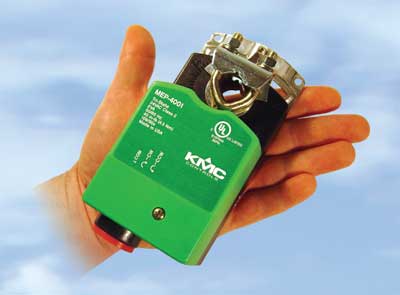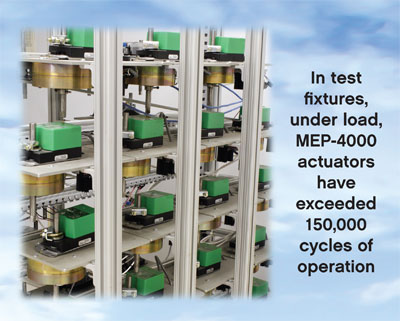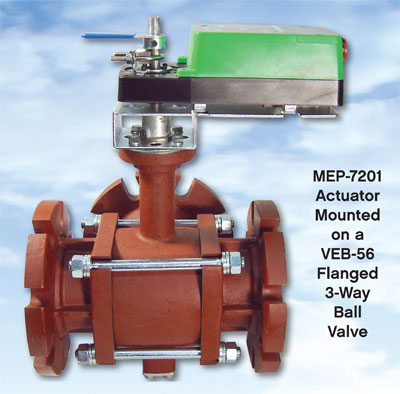Getting Physical with Actuators
In Touch with the Real World

Current Building Automation Systems (BAS) consist of digital electronics. Within the network, components talk to each other in terms of varying voltages and currents. But something more is needed to interact with the real world of air and water flow that is used to control temperature in the HVAC systems of commercial and industrial buildings. The devices that translate voltages (e.g., supplying 0 to 10 volts) into physical motion (e.g., rotating 0 to 90 degrees) are actuators. Actuators take the place of somebody’s hand to turn a handle on a valve or damper.
From palm-sized-but-powerful 40 or 80 in-lbs. to a tremendous 320 in-lbs. of actuator torque, KMC ControlSet actuators precisely and efficiently control the most demanding applications. These actuators were designed to provide continual, dependable control of air dampers and valves in HVAC systems.
They are designed to rigorous performance criteria and manufactured in the U.S.A. to the industry’s most exacting quality control standards, and, as a result, they perform perfectly day in and day out. Every KMC actuator made is functionally tested during the production process, and sample units in each production run are fully examined to ensure complete quality standard compliance. The total quality control process is so effective that KMC consistently records near zero-ppm-defects in every product line. Few manufacturers offer this kind of performance because KMC’s commitment to extreme quality production standards is unmatched.

Actuator Types and Features
Proportional MEP-4xx2 and MEP-72x2/75x2/78x2 models accept a 0–10 VDC control signal input from a thermostat or controller. “Anti-jitter” circuitry significantly reduces hunting and needless wear on the actuator and valve packing or damper components (from unnecessary miniscule position changes caused by undamped analog input signals). A user-initiated, auto-mapping feature provides more precise equipment control by reassigning the input signal range over the desired reduced rotation range. A 0–5 or 0–10 VDC (switch-selectable) feedback voltage output is proportional to the actuator position.
In addition, MEP-537x and MEP-7x5x models have a fail-safe feature that will drive the actuator to the fail-safe position during a loss of power to the actuator. Capacitor-driven fail-safe models provide switch-selectable direction and (because extra motor torque to overcome spring resistance on every cycle is not needed) higher energy efficiency over spring-return actuators. Because springs typically break after about 50–60K cycles, capacitor-driven actuators can last three times longer. Also, spring returns drive much faster during fail-safe mode, potentially damaging equipment, but capacitor-driven actuators provide consistent torque during fail-safe as well as powered modes.
Tri-state (or “floating”) actuators move one direction while 24 VAC is applied to a set of terminals, and they move the opposite direction while 24 VAC is applied to a different set of terminals. In addition, fail-safe tri-state actuators (MEP-5373/5374 and MEP-7x51/7x53 models) can be wired for two-position (fully open or fully closed) operation if desired.
(For older systems, KMC also sells
pneumatic actuators and other analog electronic actuators in addition to the ControlSet line.)
Easy Installation

ControlSet actuator installation couldn’t be easier. Slide the actuator over the shaft, position and lock it, screw down the anti-rotation bracket, and wire the terminals. Setup for proportional models is a switch for CW or CCW rotation for an increase in control signal voltage. Setup for fail-safe models is another switch for CW or CCW rotation during a power loss. All models also have a gear disengagement feature to assist in setup or checkup. It’s that simple.
Additional Resources
To learn more about hydronics and the valves listed on this page, see Superior Flow Control with Ball Valves.
To help choose the best actuator for your needs, try out our Actuator Selection Tool.
See Also:
When Failure Is Not an Option: The Evolution of Fail-Safe Actuators
 ControlSet Actuators Brochure (SB-009)
ControlSet Actuators Brochure (SB-009)
Comments